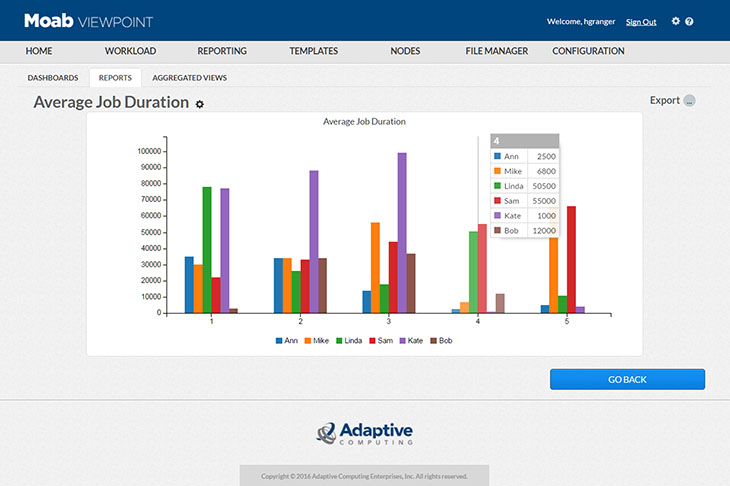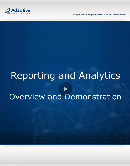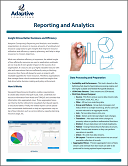Reporting and Analytics
Reporting and Analytics
Insight Drives Better Decisions and Efficiency
Adaptive Computing’s Reporting and Analytics tool enables organizations to gain insights by streaming resource usage and workload data into custom reports and personalized dashboards.This drives…
- Improved resource utilization and efficiency
- Better capacity planning
- Greater alignment of resources to mission objectives
How It Works
Viewpoint Reporting and Analytics enables organizations to create data streams that pull in job, node, credential and resource information from Moab and TORQUE and correlate that information into aggregated views. These aggregated views can then be further refined into visualized chart-based reports or structured tables. Finally, the related reports can be placed into customizable dashboards to help an organization stay on top of key indicators such as service delivery, capacity planning, resource usage, etc.
- Stream data with lightning-fast Apache Spark processing engine and flexible Mongo database.
- Process data to ensure relevance with traditional analytical functions (group, reduce, join, filter, etc.)
- Visualize aggregated information in chart-based reports or structured tables.
- Monitor key indicators in customizable dashboards
- Drive better decision-making and policy enforcement.
Data Processing and Preparation
- Scalability and Performance – This tool is based on the lightning-fast Apache Spark data processing engine and the highly scalable and flexible MongoDB database.
- JSON Data Streams – Data streams are JSON based.
- Rich Data Stream Designer:
- Source – Pick from various source data streams (job, reservation, node, ACL, etc.).
- Filter – Sift out non-matching data.
- Group and Reduce – Group data messages and reduce them to a single record (e.g. all of a user’s job records reduced to an aggregate result).
- Join – Tie two data streams into one.
- State – Detect and intercept object state changes.
- Transform – Alter data with inline changes to property values or perform mathematical functions.
- Distinct – Ensure data does not include duplicates.
- Flatten – Change hierarchical to flat data structures.
- Fork – Process data streams so they can perform operations in parallel.
- Union – Re-unite two data streams.
- DB Layout – Transform a data stream into an actual queriable collection of records.
- Aggregated Views – Preview aggregated views of data streams and estimate how fast results are able to be produced for tuning optimal report experience.
Data Streams and Aggregated Views
The reporting engine produces JSON streams of data, which can be augmented using traditional data analytics functions such as group, reduce, join, filter, etc. These streams are then stored in the database collection. Adaptive Computing’s reporting engine is based on Apache Spark and stored in our MongoDB database to maximize scalability and performance.
Reports
To create a new report, users select aggregated views to which they have access. Then, using an SQL query editor, they specify data fields, detail granularity, output (chart or table), and preview the resulting chart before creating it. The results can be applied individually as a report, implemented into a dashboard, or exported to .pdf, .csv, or an image file. When running reports, users specify a refresh rate and pass inputs that filter the results (time frame, user, user group).
The Reporting and Analytics engine comes with dozens of pre-defined reports as well as a rich UI-based designer which allows for customization.
- Average Wait Times – User, group, account, class and QoS
- Job State Duration – Idle, Starting, Running, Hold, etc.
- Highest Requested – Resources, partitions, features, etc.
- Allocated/Utilized Resources – User, group, etc.
- Outage Impact – Node state percentages per time period
- Job Start Time Delay – Identify wait times
- Core Use Efficiency – Per utilized node
.
Dashboards
Dashboards can be used to unify the reporting elements which help produce the desired global view of the particular issue, whether it be operational, resource capacity, etc. Dashboards give users access to up to three lanes to layout the desired reports using a simple drag and drop designer. Reports can include traditional charts (line, bar, pie) or tables
Summary
Adaptive Computing’s Reporting and Analytics tool enables organizations to stream in and organize their data to gain insights to help drive better decision-making and policy enforcement. This drives improved resource utilization and efficiency, better capacity planning, and greater alignment of resources to mission objectives. Integrated directly with Viewpoint, this tool becomes a natural empowering extension for administrators and managers.





